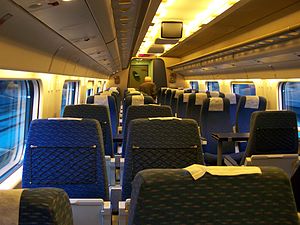Alfa Pendular
| Alfa Pendular | |
|---|---|

Alfa Pendular 4010 at Lousal in 2009.
|
|

The interior of a second class carriage.
|
|
| Manufacturer | FIAT Ferroviaria, ADtranz, Siemens |
| Built at | Sorefame, Amadora |
| Family name | Pendolino |
| Entered service | 1999 |
| Number built | 10 six-carriage units |
| Fleet numbers | Série 4000 (numbers 4001-4010 and 4051-4060) |
| Capacity | 301 seats |
| Operator(s) | CP |
| Line(s) served | Braga-Porto-Lisbon-Faro |
| Specifications | |
| Train length | 158.9 m (521 ft) |
| Width | 2.92 m (9 ft 7 in) |
| Height | 4.39 m (14 ft 5 in) |
| Maximum speed | 220 km/h (140 mph) |
| Weight | 298.3 t (293.6 long tons; 328.8 short tons) |
| Axle load | 14.3 t (14.1 long tons; 15.8 short tons) |
| Traction system | 8 asynchronous three-phase Siemens 1TB2223-OGA03 motors |
| Power output | 4,000 kW (5,400 hp) |
| UIC classification | (1A)(A1) – (1A)(A1) – 2′2′ + 2′2′ – (1A)(A1) – (1A)(A1) |
| Track gauge | 1,668 mm (5 ft 5 21⁄32 in) Iberian gauge |
 |
|
| Line length | 624 km (388 mi) (including 314 km (195 mi) - Linha do Norte) |
|---|---|
| Track gauge | 1,668 mm (5 ft 5 21⁄32 in) |
Alfa Pendular is the name of the Pendolino high-speed tilting train of Portuguese state railway company CP. It connects the cities of Braga, Porto, Aveiro, Coimbra, Santarém, Lisbon, Albufeira and Faro, among others at speeds of up to 220 kilometres per hour (137 mph).
The trains were assembled in Portugal by ADtranz at the former Sorefame works at Amadora, based on contracting partnership between Fiat-Ferroviaria as the main contractor and ADtranz and Siemens as the main subcontractors.
The Alfa Pendular high speed train is a six car electric multiple unit (EMU), which is derived from and closely resembles the Giugiaro designed Italian Fiat-Ferroviaria ETR 480 Pendolino train. The bogies had to be redesigned to operate on Portugal's 1,668 mm (5 ft 5 21⁄32 in) Iberian gauge track.
There are 8 traction motors, installed on all but the two middle vehicles of the train, developing 4.0 megawatts (5,400 hp). This M-M-T-T-M-M arrangement spreads the weight of the train, giving it a weight of only 13.5 tonnes (13.3 long tons; 14.9 short tons) per axle, which helps its cornering ability at high speed.
During testing, a top speed of 245.6 km/h (152.6 mph) was reached close to Espinho in 1998.
Its tilting train technology, with a maximum tilt angle of 8°, allows the train to negotiate curves at higher speeds than conventional trains. The combination of the resulting high cornering velocity and the tilting movement of the carriages helps ensure a comfortable ride for the passengers, although the jostle and sway compensating for track irregularities may cause "travel sickness" in those susceptible. The hydraulic tilting system is governed by two gyroscopes in the head cars. The curve is found on the base of the elevation of the external track.
...
Wikipedia
